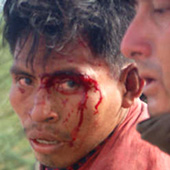
|  |  |  Editorials | Issues | June 2009 Editorials | Issues | June 2009  
Massacre in Peru: A Dispatch on the Bloody Conflict
 Catapa Catapa
go to original
June 09, 2009


| | Click HERE to see photos taken by volunteers in Peru of the conflict between the Peruvian government and the Amazon people. Warning - some pictures are shocking. |  |
The enduring conflict in Bagua (North Peru) between the Peruvian government and indigenous inhabitants of the Amazon have led to violent confrontations on Friday, June 5. According to different sources, between 30 and 84 deaths are reported, and more than 100 were wounded when the security forces tried to stop a roadblock by using violent force.

According to the police, the indigenous people fired at the policemen first. This is contended by the representatives of the different indigenous groups: they say that they were only armed with their traditional spears. Most sources affirm that shots were released from police helicopters. Thomas and Marijke also saw how the police took along corpses. "A way to decrease the official death count", says Marijke Deleu of Catapa.

Announced conflict

The stake of the conflict is the admittance of mutinational companies to the areas in Northern Peru, which is rich in oil, gas and mineras. For almost two months, more than 30 000 indigenous inhabitants of different provinces of the Amazon and the Highlands protest the way in which the state and companies want to invest in the exploitation of natural resources. Indigenous people and farmer communities want to take part in the decision making process about the development of the land.

During 57 days, indigenous people were on strike and blocked roads. The last two years a large number of ecological and social restrictions on extraction of resources were removed by a changing regulation, leading to a much less restrictive legislation. This eases direct foreign investments in Peru for developing mines and oil- and gas-exploitations and concessions.

On May 9, the Peruvian governement declared the state of emergency in seven provinces of the Amazon areas, which means that "the constitutionally provisions on freedom and security of persons and the immunity of accommodation are temporarily suspended, and that there is a ban on gathering". Officially to safeguard acces to roads and airports, and to prevent production losses due to the actions of the indigenous people. However, on Friday it appeared as an alibi for using violence.

Negotiations between the state and the representatives of the indigenous communities were ceased on may 15, whereafter the indigenous people announced that they would continue their actions. Ever since, the protest and the reactions of the governement became more grim.

Convention 169 forces the consultation of indigenous people

C169 Indigenous and Tribal Peoples Convention, set up by the International Labour Organisation and ratified by Peru in 1994, obliges Peru to consult indigenous people in cases in which the State or a company plans to exploit the natural resources in the land that the indigenous people occupy. This however is not a common practice in the Amazon forest. The biodiversity and the lives of indigenous people are at stake. The Sate and the companies involved – including the French oilcompany Perenco and the Spanish company REPSOL – push for a quick exploitation. The Peruvian Amazon forest are wanted for its potential profits, in a worldwide context of a growing shortage of natural resources.

Critizising to the actions by the indigenous people, president García referred in a statement by the government to the contitution that “the State retains the ownership of sub-surface resources” and that “all Peruvian people have to profit the natural resources in the country”. The indigenous people do not claim the ultimate ownership of the Amazon forest, but ask for a voice in the decision making process in the development of the region. Alberto Pizango, leader of the umbrella indigenous people's organisation AIDESEP, explaines: “we do not fight development, but we ask for development from our perspective”.

Click HERE to see photos taken by volunteers in Peru of the conflict between the Peruvian government and the Amazon people. Warning - some pictures are shocking. |

 |
|  |



